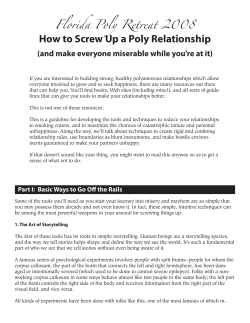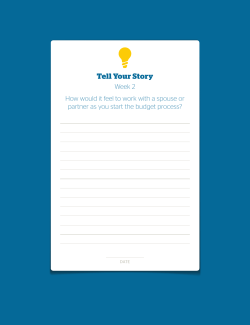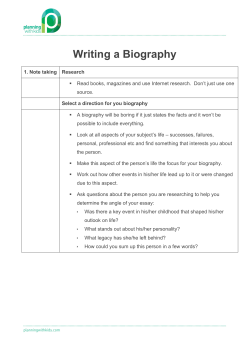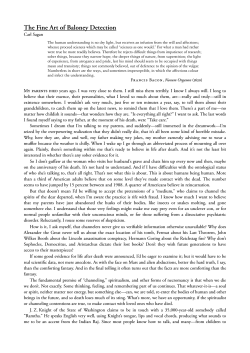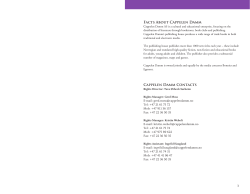
How to Make a Boring Interesting GENI WHITEHOUSE
How to Make a Boring Subject Interesting 52 ways even a nerd can be heard GENI WHITEHOUSE Copyright © 2009 by Geni Whitehouse. All Rights Reserved. No part of this book may be reproduced or transmitted in any form or by any means, electronic or mechanical, including photocopying, recording, or by any information storage and retrieval system, without permission in writing from the publisher except by a reviewer who wishes to quote brief passages in connection with a review written for inclusion in a magazine, newspaper or broadcast. All trademarks, brands and names mentioned in this book are the property of their respective owners. This title may be purchased for business or promotional use or for special sales. For information, please e-mail bulksales@uptonblanding.com. Published by Upton and Blanding Associates, Pleasanton, CA, www.uptonblanding.com Cover Design and Layout: Adina Cucicov Editor: Amy Moore, www.moorewords.com Illustrations: Mary Patterson, www.fishchild.com ISBN: 978-0-692-00151-6 First Printing 2009, Printed in the United States of America. Author’s website www.EvenANerd.com Dedication In memory of Susan Sheridan Austin, the best presenter I have ever known. and To Chip and Mary Beth who have spent most of their lives fruitlessly trying to de-nerdify their Mom but who manage to support and inspire me anyway. How to Make a Boring Subject Interesting Table of Contents INTRODUCTION 5 WHERE TO BEGIN? As Far Away From Your Computer As Possible 11 1. Create a one-pager 15 2. Identify your top three message points 19 3. Use a mind mapping™ technique to generate ideas for your topic 23 A MATTER OF ENTITLEMENT Finding the Right Title for Your Presentation 4. Count on numbers 27 31 5. Recycle, reuse, repurpose 35 6. Use juxtapositioning to your advantage 39 7. Let your audience be the judge 43 TRIMMING THE FAT Sometimes It Takes a Sharp Knife and a Critical Eye 47 8. Never start your presentation with, “First, here’s some housekeeping” 51 9. Never use words when a picture will do 55 10. Avoid jargon 59 11. AAIAAP 63 12. Put the boring stuff on handouts 67 13. Know where to draw the line 71 PLUGGING IN The Joy of Seeing the Lights Come On 75 14. Make it personal 79 15. Put yourself in their shoes 83 16. Know what is top of mind for your audience right now 87 17. Imagine everyone in the room is trying to blackmail you 91 18. Adapt your presentation to fit the style of the listener 95 19. Work with the differences 99 20. Work with the similarities 103 21. Research local customs 107 22. Sell it before you tell it 111 1 How to Make a Boring Subject Interesting MARY POPPINS WAS RIGHT You Need at Least a Spoonful of Sugar to Make the Boring Stuff Go Down 115 23. Look for an oddity or humorous angle 119 24. Try a novel format 123 25. Tie your message to a season, holiday or local event 127 26. Play off any stereotypes for people like you 131 27. Use sarcasm 135 28. Design your presentation like a can of mixed nuts 139 AND THE PLOT THICKENS Everyone Loves a Good Story 143 29. Become a narrator 147 30. Look for emotions associated with your topic 151 31. Do what the politicians do. Talk about a real person 155 SIMPLIFY COMPLEX IDEAS USING PEACHES AND BASKETBALLS Concrete Items Can Help You Connect 159 32. Use substitute objects to help people find new ideas or approaches 163 33. Give people a frame of reference 167 34. If you can’t compare, contrast 171 35. Use a bonehead example to teach a brainy process 175 36. Make your information relative 179 37. Personify to clarify 183 38. Convey your concept with a formula 187 TECHNICALLY SPEAKING Applied Technology Can Make You More Human 39. Incorporate Internet content into your presentation 191 195 40. If you plan to use a computer, have a plan B (or a really capable assistant you can call) 199 41. Hand out glasses—or make sure the people in the back can see your screen 203 42. Let a robot be your muse 207 43. Insert freebies 211 2 How to Make a Boring Subject Interesting ENGAGING YOUR AUDIENCE Make the Relationship Last 215 44. Let people get hands-on with the information 219 45. Ask questions 223 46. Use more audience interactions with a small crowd 227 47. Be a facilitator 231 SHARE THE STAGE Unless the World Really Does Revolve Around You 235 48. Swing your partner 239 49. Don’t say a word 243 SPECIAL DELIVERY, ANYONE? Return Receipt Requested 247 50. Practice—know that content inside and out 251 51. Take control of your space 255 52. Take speaker training classes 259 CLOSING 263 APPENDIX 267 ACKNOWLEDGEMENTS 269 3 INTRODUCTION Introduction No subject is boring to everyone. Likewise, no subject is inherently interesting to everyone. Rather, it’s about the relationship between the communicator and the listener. The secret to communication and presentation success lies in finding a subject that is interesting to you and making it interesting to your audience. That’s what this book is about. This book is for presenters who want to have more fun with their material, who want to find a way to connect with their audience, who want to be heard. Often presenters who are saddled with boring subjects get labeled boring by virtue of association. That’s what has happened to entire professions like accounting, actuarial science, and funeral management. But it doesn’t have to be the case. This book will help you find and create the interesting in every subject. The boring versus interesting call is pretty subjective. There is no procedural checklist you can follow every time. There are lots of elements involved in good communication and when any one of them is missing, you can quickly slip into boring territory. 7 How to Make a Boring Subject Interesting Sometimes it’s a timing thing. (Ever been to a networking event immediately following your arrival on a red-eye flight? Nothing anyone says is going to keep you awake for long.) Other times it’s a delivery issue. (The presenter speaks in a monotone.) It could be a matter of failing to meet expectations or providing too much information. (I thought this was a 30 minute show—you mean I have to tune in next week to see the conclusion?) Or it could be that your audience is full of beginners and your material is advanced. (I wanted to learn how to tune an engine, not build one.) Your goal, if you are the presenter, is to find out as much as you can about your audience and create a presentation that is perfectly suited to them. Every subject is interesting to somebody. I am sure there is at least one person who is interested in the gestation period of an armadillo. (Actually, according to Google there are about 11,700 people interested enough in this topic to mention it.) But, there is an element of luck in finding a second person who is interested in that same subject. When you want your message to reach more than three people, it’s time to get serious. It’s time to read this book. This book focuses on the message. There are plenty of other great books on presenting that you should read too. (See the appendix.) 8 Introduction But this book, the one written lovingly for you by this nerd, will take you through 11 different areas that influence the power of your message. It includes 52 ideas to help you find new sources of inspiration and new ways to organize your material. Some of the tips might even get you to take a risk, to be more edgy than you’ve been in the past. Before you’re through, you might even discover that you enjoy making presentations. 9 How to Make a Boring Subject Interesting You might be wondering why I chose to write this book for nerds. In High School, I lettered in Algebra II. (You think I’m kidding.) I am a nerd. When you are a nerd, there are only a couple of career options. So of course I became an accountant. During the course of my career, one of the things I have learned is that people in business rely on us nerds. In fact, there is a nerdy engine that powers most successful businesses. Business owners need accountants. Salespeople need engineers. Software vendors need software developers. Wineries need wine makers. Drug companies need chemists. Astronauts need NASA engineers to put them in orbit. Occasionally, we might even need to consult with a medical professional who specializes in say, spasmodic dysplasia. The point is that anyone who is immersed in a unique specialty is what I would consider a “nerd” at least in that subject, and they probably have valuable insights to share with the rest of us. This book is about helping them find their voice. 10 WHERE TO BEGIN? As Far Away From Your Computer As Possible Where to Begin? M ost writers will tell you that they hate to face the blank page. And it’s no wonder. It’s easy to feel paralyzed at the beginning of a project. The white screen or page is like a mirror for your brain: completely devoid of thoughts. The flashing cursor is a menacing little bug. If it had a voice it would be saying, “Take a break. Do something else. I hate this. I’d like a donut.” That’s why I like to redefine the beginning. When you’re preparing for a presentation, don’t expect to open up a blank slide deck and just start typing. Start somewhere else. Your first steps don’t necessarily involve a forced lock-down in your chair running through all of the facts that relate to your presentation. The best ideas come to me when I’m away from the topic. I spend a little bit of time consciously thinking about the parameters of the problem, and then I leave it alone for a while. Sometimes I even start in the middle. There might be one really amazing idea, insight, or image that jumps right out from the middle of my subject and then I am able to add content before and after that. As I am out and about, I’m better able to put myself in the place of the audience. I always get inspiration on airplanes—probably because they’re the only place you don’t get interrupted by one of those marvels of modern technology. 13 How to Make a Boring Subject Interesting So give yourself time to ponder. Start by focusing on the idea, the emotion, or the reason you are making a presentation. Then follow these tips before you try to create your slides, script or handouts. 14 1 Create a one-pager. And I’m not talking about one of those nerdy devices you have clipped to your belt. Where to Begin? If you can describe all of the pertinent information about your subject on one piece of paper, then you can turn it into a presentation. Just start writing. Don’t try to edit yourself at the beginning. Your goal is to create what Betsy Burroughs likes to call “a lousy first draft.”1 Then you can start playing with your content to create a one-page document. If you haven’t tried to do this, particularly on your favorite subject, you’ll be surprised to learn how difficult it is to condense everything that you want to say onto one page. But the exercise of dumping all of your information on paper and then editing it down to a single page is extremely valuable. It will really help you choose the correct words and will give you great clarity around what information is most vital to your message. Once you have the one-pager, you have the option of adding details to form an informative handout, or paring it down further to form the basis of your presentation. Which conveniently leads me to my next point. 1 Betsy Burroughs, www.focuscatalyst.com, author of FOCUS. The Catalyst for Creativity. In your work. In your life. 17
© Copyright 2025







